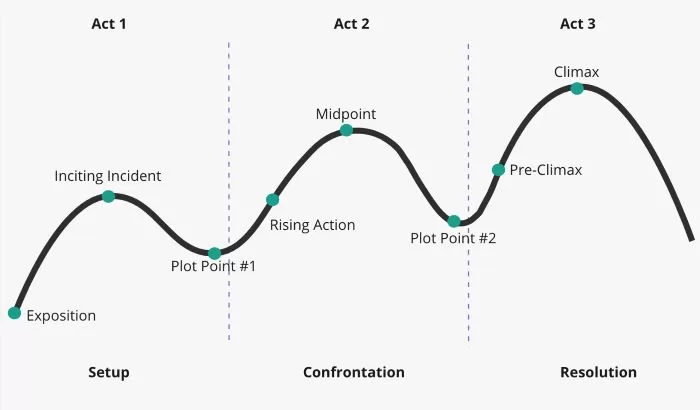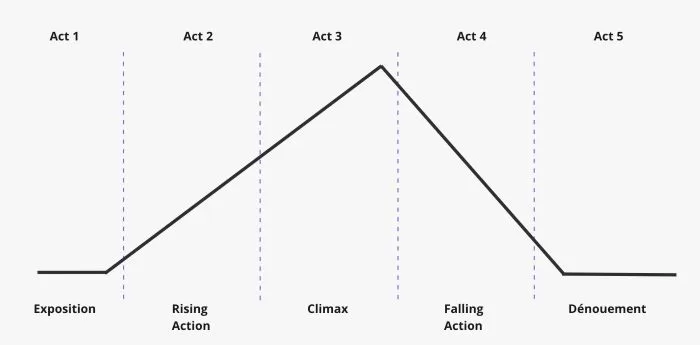Screenwriting is a delicate art that involves crafting compelling stories that engage and captivate audiences.
One crucial aspect of successful screenplay writing is the structural framework, which provides a roadmap for the narrative.
Two popular structural paradigms are the traditional 3-act structure and the more nuanced 5-act structure.
In this article, we’ll explore the key differences between these two approaches and their respective advantages in shaping memorable screenplays.
Table of Contents
The 3-Act Structure:
The 3-act structure is a time-tested method that divides a story into three distinct parts: setup, confrontation, and resolution. Each act serves a specific purpose in advancing the narrative.
- Act 1: Setup
- Introduces characters, setting, and the central conflict.
- Establishes the tone and world of the story.
- Ends with an inciting incident that propels the protagonist into the main conflict.
- Act 2: Confrontation
- The protagonist faces obstacles and challenges.
- Builds tension and develops characters.
- Ends with a major turning point or climax.
- Act 3: Resolution
- Resolves the central conflict.
- Provides closure for the audience.
- May include a twist or revelation.
The 3-act structure offers a straightforward approach that aligns with the audience’s expectations, making it a popular choice in the industry.

The 5-Act Structure:
The 5-act structure is a more intricate model that allows for additional nuance and complexity in storytelling. It originated from classical plays and was popularized by Shakespearean dramas.
- Act 1: Setup
- Similar to the 3-act structure, it introduces characters and the central conflict.
- Ends with an inciting incident.
- Act 2: Rising Action
- Expands on the conflict and introduces complications.
- Builds tension and character development.
- Ends with a major turning point.
- Act 3: Climax
- The story reaches its peak of tension.
- Major confrontations and revelations occur.
- Ends with a critical moment or twist.
- Act 4: Falling Action
- Deals with the aftermath of the climax.
- Characters respond to the events.
- Sets the stage for the resolution.
- Act 5: Resolution
- Provides final closure for the story.
- Wraps up loose ends.
- Leaves a lasting impression on the audience.

Advantages and Considerations:
- Pacing and Tension:
- The 3-act structure’s simplicity ensures a quick pace and straightforward progression, keeping audiences engaged.
- The 5-act structure allows for more gradual tension build-up and nuanced exploration of characters and subplots.
- Character Development:
- The 5-act structure provides additional acts for in-depth character exploration and evolution.
- The 3-act structure demands concise character development to fit within the limited structure.
- Flexibility:
- The 3-act structure’s rigidity can be a strength for certain genres, ensuring a clear and satisfying narrative arc.
- The 5-act structure offers more flexibility, making it suitable for complex stories that require extensive development.
- Audience Expectations:
- The 3-act structure aligns with audience expectations, providing a familiar and comfortable viewing experience.
- The 5-act structure may challenge traditional expectations, offering a fresh and unpredictable narrative.
Conclusion:
Choosing between the 3-act and 5-act structure ultimately depends on the story being told and the writer’s stylistic preferences.
While the 3-act structure remains a reliable and widely embraced formula, the 5-act structure provides a canvas for intricate storytelling and character exploration.
Successful screenwriters understand the nuances of both structures, utilizing them as tools to craft narratives that resonate with diverse audiences.
Whether adhering to tradition or pushing the boundaries, the key lies in creating a compelling story that captivates and lingers in the minds of viewers long after the credits roll.
FAQs
Q1: What is the primary difference between the 3-act and 5-act structures in screenwriting?
A: The main difference lies in the number of acts and the level of complexity each structure offers. The 3-act structure simplifies the narrative into setup, confrontation, and resolution, while the 5-act structure introduces additional acts, allowing for more nuanced storytelling.
Q2: Which genres or types of stories are better suited for the 3-act structure?
A: The 3-act structure is well-suited for genres that benefit from a clear, straightforward narrative arc, such as action, comedy, and many mainstream films. It provides a familiar and satisfying structure for audiences.
Q3: In what ways does the 5-act structure offer more flexibility to storytellers?
A: The 5-act structure provides additional acts like rising action, falling action, and climax, allowing for a more gradual and detailed exploration of characters and subplots. This flexibility makes it suitable for complex, character-driven narratives.
Q4: How does each structure handle character development differently?
A: The 3-act structure demands concise character development to fit within its limited structure. In contrast, the 5-act structure offers more acts for in-depth character exploration and evolution, allowing audiences to connect with characters on a deeper level.
Q5: Which structure is more likely to challenge audience expectations?
A: The 5-act structure, with its additional acts and potential for unexpected twists, is more likely to challenge traditional audience expectations. This can be advantageous for storytellers aiming to provide a fresh and unpredictable narrative experience.
Q6: Are there any specific advantages of the 3-act structure in terms of pacing and engagement?
A: Yes, the 3-act structure’s simplicity ensures a quick pace and straightforward progression. This can enhance engagement, especially in genres where audiences expect a more direct and streamlined storytelling approach.
Q7: How do these structures impact the resolution of a story?
A: Both structures aim to provide resolution, but the 3-act structure often delivers it in a more conventional manner in the final act. The 5-act structure, on the other hand, may distribute resolution elements across multiple acts, offering a more layered and intricate conclusion.
Q8: Can a screenplay combine elements of both structures?
A: Absolutely. Many screenwriters blend elements of both structures based on the needs of their story. It’s a creative choice that allows for a customized approach, leveraging the strengths of each structure to create a unique and compelling narrative.
Q9: Are there any famous films that adhere strictly to either the 3-act or 5-act structure?
A: Many successful films follow the 3-act structure, including classics like “Star Wars” and “The Godfather.” The 5-act structure is often associated with Shakespearean plays, but modern films like “The Dark Knight” have also incorporated its principles.
Q10: Which structure is more suitable for aspiring screenwriters to begin with?
A: Many industry professionals recommend starting with the 3-act structure for beginners due to its simplicity and widespread acceptance. As writers gain experience, they can explore and experiment with the more intricate 5-act structure or create hybrids that suit their storytelling style.



Comments